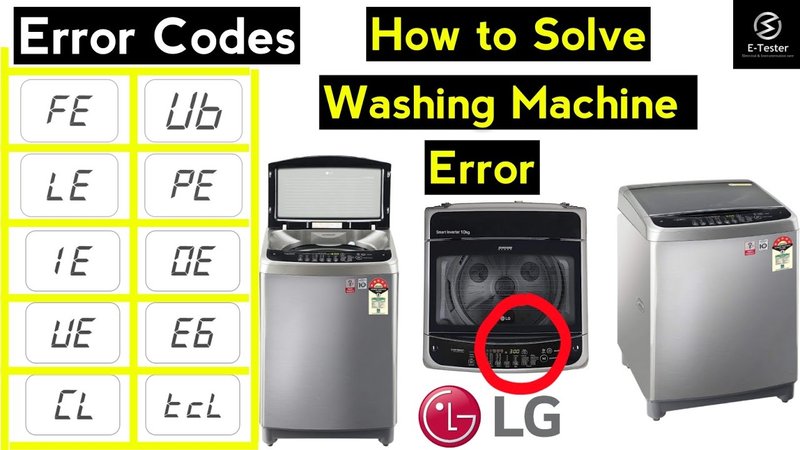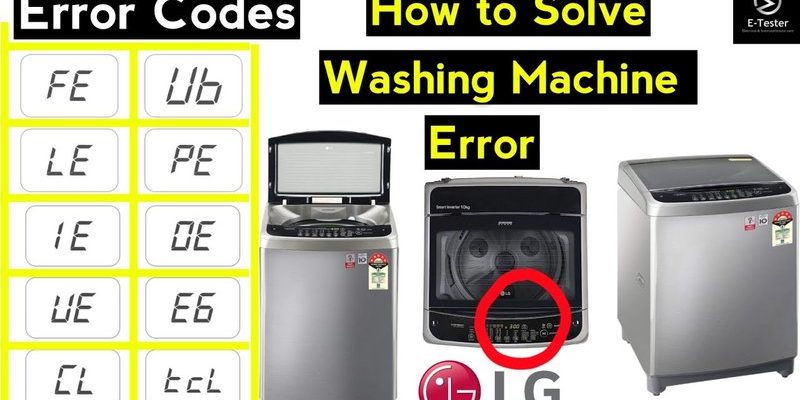
In the world of washing machines, a lot can happen behind the scenes. Each code is like a little message from your washer, letting you know when something’s off. The E2 error code is a common alert that LG washing machine owners might encounter. It’s typically associated with draining issues. Ignoring it might seem tempting, especially when you’re hoping that it’s just a minor hiccup, but there are good reasons why you should understand and address it. In the upcoming sections, we’ll explore what causes this error, what it means for your laundry routine, and how you can tackle it like a pro, even if you’re not particularly tech-savvy.
Understanding the E2 Error Code
So, what’s the deal with the E2 code? In simple terms, the E2 error in LG washing machines generally points to a problem with the draining system. Imagine trying to pour water out of a bottle when something’s blocking the neck — that’s kind of what’s happening inside your washer. It’s trying to drain the water after a wash cycle, but something might be obstructing the flow.
One of the most common culprits is a clogged drain pump filter. Over time, things like lint, coins, or small clothing items like socks can find their way into your washer’s intricate parts. Just like how a clogged sink might need a good plunge, your washing machine might need a little attention to clear the blockage. Leaving it as it is can cause your machine to overwork itself, leading to more severe issues down the line.
If you’re wondering why this happens, think about how much stuff your washer deals with every time you do a load. It’s no surprise that these issues crop up, but the good news is they’re usually fixable with some basic troubleshooting. Tackling the problem early can save you from a bigger headache (and expense) later on.
Why You Shouldn’t Ignore the E2 Error
You might be tempted to ignore the E2 error, thinking it’s just a minor glitch. But here’s why that’s not the best idea. Your washing machine is like a well-oiled machine — all the parts have to work in harmony. When something disrupts this flow, like a drainage problem, it can affect other parts of the system, leading to bigger issues.
Ignoring the error could result in water remaining in the drum after cycles, leading to mold and mildew growth. Not only is this unhealthy, but it can also lead to unpleasant odors in your washer and clothes. Over time, the persistent issue might strain the pump motor, causing it to burn out. Just imagine running a marathon while dragging a heavy weight — it’s bound to cause problems eventually.
Addressing the error promptly ensures that your clothes are being washed in fresh, clean water and saves you from potential repairs. Plus, it prolongs the life of your washing machine, keeping everything running smoothly. So, while ignoring it might seem convenient now, dealing with it proactively is the smart choice.
Steps to Fix the E2 Error
Ready to tackle the E2 error head-on? Here’s how you can do it. First things first, you’ll want to unplug your machine to ensure safety. Safety tops the list, as you don’t want any surprises while handling electrical appliances. Then, locate the drain pump filter; this is usually at the bottom front of the washer. It might be hidden behind a small panel, so check your user manual if you’re unsure.
Once you’ve found the filter, twist it open and brace yourself for some water spillage. It’s like opening a can of soda that’s been shaken — a bit messy but manageable. Have a bowl or some towels handy to catch any water. Inspect the filter for any debris that might be causing a blockage and clean it thoroughly. If you find anything like socks or lint, gently remove them and rinse the filter under water.
After cleaning, replace the filter securely, close the panel, and plug your washer back in. Run a quick cycle to check if the error code has disappeared. If everything looks good, give yourself a pat on the back — you’ve just tackled the E2 error! If the error persists, it might be worth contacting a professional technician to delve deeper into the issue.
Preventing Future E2 Errors
Now that you’ve tackled the error, let’s talk about keeping it from coming back. Just like maintaining a car or any other appliance, a little preventive care goes a long way. One great habit is to regularly check and clean the drain filter. Doing this once a month can prevent future build-up and save you from surprise errors.
Another tip is to be mindful of what goes into your washing machine. Check pockets for small items before washing. Imagine a washing machine as a babysitter to your clothes — it works best when you don’t overwhelm it with unexpected surprises like coins. Also, consider using a mesh laundry bag for smaller items to keep them contained.
Lastly, running an empty hot water cycle with a cup of vinegar can help keep the drum and pipes clean from residual detergent and gunk. This easy trick keeps your machine fresh and reduces the risk of clogs. Keeping these preventive measures in mind will ensure your machine runs efficiently, keeping your laundry routine smooth and hassle-free.
In conclusion, while the E2 error can be a bit of a nuisance, understanding it and knowing how to deal with it makes a world of difference. By paying attention to these warning signs and taking proactive steps, you can ensure a long-lasting relationship with your washing machine. So next time you see that pesky code, you’ll know exactly what to do!
